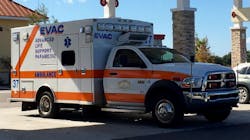Adding to the demand of an already strained ambulance system — one that receives 90,000 emergency calls a year — Volusia County's paramedics are asked to help hospitals.
Whenever there's a need to move a patient from one facility to another for specialized care, EVAC's ambulances are summoned to provide transport. Perhaps it wouldn't be an issue if it didn't happen so often, or take so long.
It occurs about 13 times a day. Each transfer, some of which require traveling into another county, takes about two hours, records show — much longer than it typically takes to close out an emergency call.
That's a problem for a system that's taking heat for its response times and ambulance availability. And while county officials contend that their emergency management operation is a "good system" overall, this is one facet that they are actively working to improve for next year.
Interim County Manager George Recktenwald and new Public Protection Director Joe Pozzo have been meeting weekly with paramedics and fire safety staff since early October to pore over data and brainstorm ways to do better. And now, after securing a $638,400 state grant, the county is ready to roll out new programs, technology and ideas. The changes were prompted, in part, by the criticism that sprung up this year from Port Orange city officials, some residents and a county councilwoman.
"The criticism was positive for us," Pozzo said. "We heard it, we listened, we acted on it quickly. ... It's a good system, but it's about to get even better."
In January, Pozzo and Recktenwald will present the findings from these weekly meetings with emergency personnel to the County Council. By then, some of the changes to come out of these meetings will have already been underway in a trial basis.
The grant money will be used to upgrade and expand emergency medical service reporting software and to expand the ambulance deployment software; to launch a community outreach and education program to teach people when it's appropriate to call 9-1-1; and to send out other options for help when an ambulance isn't necessary, such as a taxi-type service or nurse triage.
That's on top of changes the county has already rolled out this year: two basic life support ambulances were added to the fleet in October to respond to non-emergency calls. This frees up ambulances with better technology for more serious incidents. The county also added eight paramedic positions.
Those additions to the county's budget came on the heels of complaints by Port Orange city officials. In a show of no confidence for the county's EMS system, they voted this summer to buy an ambulance — a move that forced a boost in property taxes on residents, but one that City Commissioner Drew Bastian felt was necessary to "take care of citizens."
In criticizing EVAC, County Councilwoman Heather Post has used data reports at council meetings to bolster her argument that there are problems with the system.
In September, she gave examples of times when patients had to wait between 30 minutes and an hour for an ambulance to arrive. In an October Facebook post, she said there have been 3,305 emergency medical calls through Sept. 24 in which it took at least 15 minutes for an ambulance to arrive on scene from the time the call was received.
"Every day that goes by is another day in which this way of operation continues to provide inadequate public safety service to people in need in our county," Post wrote.
Ambulances and paramedics are only one arm of Volusia County's two-tiered emergency response system. Often firetrucks are the first to arrive at an emergency to administer aid with their paramedics, so only looking at when an ambulance arrives may not tell the whole story.
The majority of council members have expressed confidence in the system. The county's medical director, Peter Springer, has too. In September, in response to questions from Post, he told the council that the average response time for emergency calls is 7½ minutes, which is well within industry standards.
But with a system so large and complex — 50 ambulances, staffed by more than 150 paramedics, transporting more than 50,000 patients a year across 1,432 square miles of Volusia County — Recktenwald understands that it's open to some degree of criticism from the public, which he said "isn't necessarily unfair."
"We make mistakes," Recktenwald said in a recent interview. "But it's not like we aren't self-critiquing too. I think you can always improve the system."
The criticism, he added, prompted a closer inspection into the operation, which began in October with the weekly meetings. Those started after Pozzo, a former Port Orange fire chief whose career began as a paramedic in the 1970s, was asked to leave his most recent position in the county's human resources division and take over public protection following the resignation of Terry Sanders.
The sharp focus on EMS by Pozzo and Recktenwald, who became interim manager in June after the resignation of Jim Dinneen, is a welcome sight to Jason Lademann, president of the county's EMTs and paramedics union. He's happy that the new county leaders are making strides to overhaul the system for the first time in years.
"The attention EMS has been receiving has been a breath of fresh air and motivating to the boots on the ground employees," Lademann said. "It's definitely the most attention EMS has gotten in the past several years."
___ (c)2018 The News-Journal, Daytona Beach, Fla. Visit The News-Journal, Daytona Beach, Fla. at www.news-journalonline.com Distributed by Tribune Content Agency, LLC.






